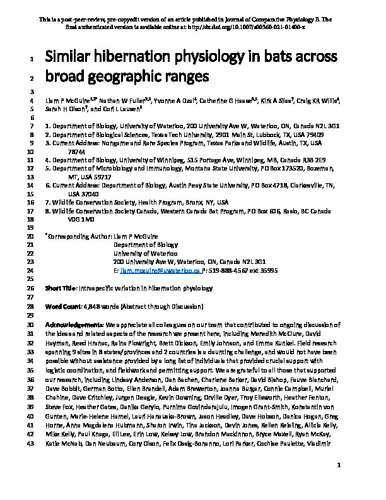| dc.contributor.author | McGuire, Liam P. | |
| dc.contributor.author | Fuller, Nathan W. | |
| dc.contributor.author | Dzal, Yvonne A. | |
| dc.contributor.author | Haase, Catherine G. | |
| dc.contributor.author | Silas, Kirk A. | |
| dc.contributor.author | Willis, Craig K.R. | |
| dc.contributor.author | Olson, Sarah H. | |
| dc.contributor.author | Lausen, Cori L. | |
| dc.date.accessioned | 2022-01-24 17:57:21 (GMT) | |
| dc.date.available | 2022-01-24 17:57:21 (GMT) | |
| dc.date.issued | 2021-08-23 | |
| dc.identifier.uri | https://doi.org/10.1007/s00360-021-01400-x | |
| dc.identifier.uri | http://hdl.handle.net/10012/17947 | |
| dc.description | This is a post-peer-review, pre-copyedit version of an article published in Journal of Comparative Physiology B. The final authenticated version is available online at: http://dx.doi.org/10.1007/s00360-021-01400-x | en |
| dc.description.abstract | Species with broad geographic ranges may experience varied environmental conditions throughout their range leading to local adaptation. Variation among populations reflects potential adaptability or plasticity, with implications for populations impacted by disease, climate change, and other anthropogenic influences. However, behavior may counteract divergent selection among populations. We studied intraspecific variation in hibernation physiology of Myotis lucifugus (little brown myotis) and Corynorhinus townsendii (Townsend's big-eared bat), two species of bats with large geographic ranges. We studied M. lucifugus at three hibernacula which spanned a latitudinal gradient of 1500 km, and C. townsendii from 6 hibernacula spread across 1200 km latitude and 1200 km longitude. We found no difference in torpid metabolic rate among populations of either species, nor was there a difference in the effect of ambient temperature among sites. Evaporative water loss was similar among populations of both species, with the exception of one C. townsendii pairwise site difference and one M. lucifugus site that differed from the others. We suggest the general lack of geographic variation is a consequence of behavioral microhabitat selection. As volant animals, bats can travel relatively long distances in search of preferred microclimates for hibernation. Despite dramatic macroclimate differences among populations, hibernating bats are able to find preferred microclimate conditions within their range, resulting in similar selection pressures among populations spread across wide geographic ranges. | en |
| dc.description.sponsorship | Department of Defense Strategic Environmental Research and Development Program || United States Fish and Wildlife Service, Grant F17AP00593 || Texas Tech University || Alberta Conservation Association. | en |
| dc.language.iso | en | en |
| dc.publisher | Springer | en |
| dc.relation.ispartofseries | Journal of Comparative Physiology B; | |
| dc.subject | hibernation | en |
| dc.subject | torpid metabolic rate | en |
| dc.subject | evaporative water loss | en |
| dc.subject | local adaptation | en |
| dc.subject | myotis lucifugus | en |
| dc.subject | corynorhinus townsendii | en |
| dc.title | Similar hibernation physiology in bats across broad geographic ranges | en |
| dc.type | Article | en |
| dcterms.bibliographicCitation | McGuire, L. P., Fuller, N. W., Dzal, Y. A., Haase, C. G., Silas, K. A., Willis, C. K. R., Olson, S. H., & Lausen, C. L. (2021). Similar hibernation physiology in bats across broad geographic ranges. Journal of Comparative Physiology B. https://doi.org/10.1007/s00360-021-01400-x | en |
| uws.contributor.affiliation1 | Faculty of Science | en |
| uws.contributor.affiliation2 | Biology | en |
| uws.typeOfResource | Text | en |
| uws.peerReviewStatus | Reviewed | en |
| uws.scholarLevel | Faculty | en |

